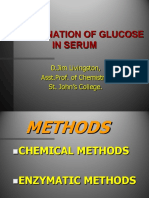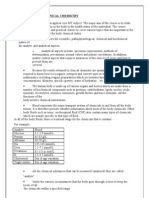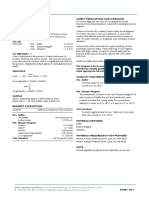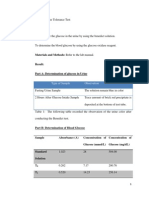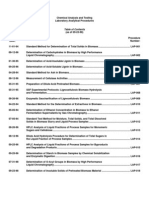0 ratings0% found this document useful (0 votes)
266 viewsGlucose Estimation
This document describes the glucose oxidase method for estimating blood glucose levels. It involves using the enzyme glucose oxidase to catalyze the oxidation of glucose into gluconic acid and hydrogen peroxide. The hydrogen peroxide then reacts with 4-aminophenazone and phenol to form a colored compound, with the intensity of color proportional to the glucose concentration. The procedure involves taking blood and standard samples, adding glucose reagent, measuring absorbance after 10 minutes, and calculating glucose concentration using the standard absorbance values. Normal blood glucose ranges provided are 70-110 mg/dl fasting and 70-180 mg/dl random.
Uploaded by
ZahidKhanCopyright
© © All Rights Reserved
We take content rights seriously. If you suspect this is your content, claim it here.
Available Formats
Download as PPTX, PDF, TXT or read online on Scribd
0 ratings0% found this document useful (0 votes)
266 viewsGlucose Estimation
This document describes the glucose oxidase method for estimating blood glucose levels. It involves using the enzyme glucose oxidase to catalyze the oxidation of glucose into gluconic acid and hydrogen peroxide. The hydrogen peroxide then reacts with 4-aminophenazone and phenol to form a colored compound, with the intensity of color proportional to the glucose concentration. The procedure involves taking blood and standard samples, adding glucose reagent, measuring absorbance after 10 minutes, and calculating glucose concentration using the standard absorbance values. Normal blood glucose ranges provided are 70-110 mg/dl fasting and 70-180 mg/dl random.
Uploaded by
ZahidKhanCopyright
© © All Rights Reserved
We take content rights seriously. If you suspect this is your content, claim it here.
Available Formats
Download as PPTX, PDF, TXT or read online on Scribd
You are on page 1/ 10
Estimation of Blood Glucose level
Mr. Arif Ullah Khan Niazi
Lecturer
Bannu College of Medical Technologies Bannu
BLOOD GLUCOSE
There are three commonly used methods for glucose
estimation, which are;-
• Copper reduction method (Folin-Wu method)
• Other reduction method such as orthotoludine
method
• Enzymatic methods such as
o Hexokinase method
o Glucose oxidase method (Recommended)
o Glucose dehydrogenase method
Estimation of Blood Glucose Level
Glucose Oxidase Method (Enzymatic method)
Apparatus:
Spectrophotometer/Colorimeter
Adjustable micropipette
Blood collection kit
Ordinary test tubes
Centrifuge with test tubes.
Estimation of Blood Glucose Level
Chemical required: Blood sample, Glucose standard, Glucose
reagent & Anti-coagulant
1. Concentration of Glucose standard= 100 mg/dl
2. Composition of Glucose reagent:
I. Glucose oxidase---------------------15 KU/L
II. Mutarotase----------------------------2 KU/L
III. Hydrogen peroxidase-------------1.5 KU/L
IV. Phenol------------------------------0.75 mol/L
V. 4-aminophenazone--------------0.25 mol/L
VI. Phosphate buffer-------------------0.1 mol/L
Estimation of Blood Glucose Level
Principal:
The enzyme Glucose oxidase catalyzes the oxidation of glucose
to Gluconic acid with the formation of Hydrogen peroxidase.
The enzyme peroxidase breaks down hydrogen peroxidase into
water and nascent oxygen. The nascent oxygen reacts with the
colorless electron acceptor 4-aminophenazone which is
oxidized to colored compound. The reaction can be followed
photo metrically. The intensity of color produced is
proportional to the amount of glucose in the sample:
Glucose+H2O+O2-------------------------------Gluconic acid+H2O2
Glucose oxidase
Estimation of Blood Glucose Level
Procedure:
Take 20 micro liter of the sample in the adjustable micropipette. Pour it into a small
test tube labeled as “UNKNOWN”.
Take 20 micro liter of the glucose standard in another small test tube labeled as
“STANDARD”.
In another small test tube labeled as “BLANK” take 20 micro liters of distilled water.
Now add 2 ml of the glucose reagent to all the three test tubes. Wait for at least 10
minutes so that the reaction is complete at room temperature.
Now switch on the colorimeter or spectrophotometer and do its blanking by first
placing the “BLANK” in the path of the light.
Use the filter/monochromator of special wavelength. The routinely used is of 546
nm. Optical length of cuvette=1 cm. Temperature =20-25 or 37 degree centigrade.
Note the transmittance or the absorbance of the unknown and that of the
standard(known).
Estimation of Blood Glucose Level
Observation & Calculation:
Formula : C1/C2 = A1/A2
C1=A1/A2 × C2
Where C1= Concentration of Unknown/Test=?
C2= Concentration of Standard=1mg/ml.
A1= Color absorbance of Unknown/Test.
A2= Color absorbance of Standard.
Estimation of Blood Glucose Level
Observation & Calculation:
Formula: Concentration of T × 100
Concentration of S
Estimation of Blood Glucose Level
Normal Blood Glucose range:
Venous blood (Fasting)= 70-110 mg/dl
Venous blood (Random)= 70-180 mg/dl
CSF = 50-80 mg/dl
Urine= up to 25 mg/dl
THANK YOU
You might also like
- Determination of Reducing Sugar by DNS Method82% (11)Determination of Reducing Sugar by DNS Method3 pages
- Ensymm Invert Sugar Production Abstract-1No ratings yetEnsymm Invert Sugar Production Abstract-110 pages
- Diagnostic Biochemistry. (Ms 1st &2nd Sem.3rd Year) Part-3newNo ratings yetDiagnostic Biochemistry. (Ms 1st &2nd Sem.3rd Year) Part-3new94 pages
- What Is Being Tested?: White Blood CellsNo ratings yetWhat Is Being Tested?: White Blood Cells48 pages
- CM Sputum Examination Ocfemia Eliazel G.No ratings yetCM Sputum Examination Ocfemia Eliazel G.41 pages
- Urinalysis (Part-2) Constituents of Urine: AbnormalNo ratings yetUrinalysis (Part-2) Constituents of Urine: Abnormal49 pages
- Culture Bacterial Media Methods by Conventional Automated NotesNo ratings yetCulture Bacterial Media Methods by Conventional Automated Notes12 pages
- Alkaline Phosphatase Kit Mod Kind King MethodNo ratings yetAlkaline Phosphatase Kit Mod Kind King Method2 pages
- Hotometry: Presenter: DR - Anurag YadavNo ratings yetHotometry: Presenter: DR - Anurag Yadav28 pages
- BIOchem - Glucose - Tolerance - Report - ) TOMNo ratings yetBIOchem - Glucose - Tolerance - Report - ) TOM20 pages
- Basic Equipment Used in Biochemistry LaboratoryNo ratings yetBasic Equipment Used in Biochemistry Laboratory13 pages
- Clinical Chemistry - Analytical Techniques, Reagent Preparation, and AutomationNo ratings yetClinical Chemistry - Analytical Techniques, Reagent Preparation, and Automation9 pages
- Cholesterol - Liquizyme CHOD-PAP (Single Reagent) PDFNo ratings yetCholesterol - Liquizyme CHOD-PAP (Single Reagent) PDF2 pages
- Object: To Estimate Blood Sugar Level From Given Sample of BloodNo ratings yetObject: To Estimate Blood Sugar Level From Given Sample of Blood2 pages
- Estimation of Blood Glucose: Glucose Oxidase Quinone Enzyme PeroxidaseNo ratings yetEstimation of Blood Glucose: Glucose Oxidase Quinone Enzyme Peroxidase2 pages
- Carbohydrate Nutrition and Skill Performance in Soccer: Ian Rollo Clyde WilliamsNo ratings yetCarbohydrate Nutrition and Skill Performance in Soccer: Ian Rollo Clyde Williams8 pages
- Specimen QP - Paper 2 AQA Chemistry AS-levelNo ratings yetSpecimen QP - Paper 2 AQA Chemistry AS-level24 pages
- New Test - February 14, 2018: MarkschemeNo ratings yetNew Test - February 14, 2018: Markscheme28 pages
- Investigatory File Chemistry For Class 12 PallaviNo ratings yetInvestigatory File Chemistry For Class 12 Pallavi23 pages
- Food, Nutrients, Basic Concepts in Human Nutrition Lecture Notes For PT 3No ratings yetFood, Nutrients, Basic Concepts in Human Nutrition Lecture Notes For PT 350 pages
- Top 100 PYQs for BITSAT for Chemistry (1)No ratings yetTop 100 PYQs for BITSAT for Chemistry (1)142 pages
- 03 2017 Espen Carbohydrates and Insulin Resistance in Clinical NutritionNo ratings yet03 2017 Espen Carbohydrates and Insulin Resistance in Clinical Nutrition9 pages
- (Mebooksfree Com) Ant&Dia&Mel&Pla&Sub&1stNo ratings yet(Mebooksfree Com) Ant&Dia&Mel&Pla&Sub&1st409 pages
- Halophile, an essential platform for bioproductionNo ratings yetHalophile, an essential platform for bioproduction8 pages









